We may receive a commission when you use our affiliate links. However, this does not impact our recommendations.
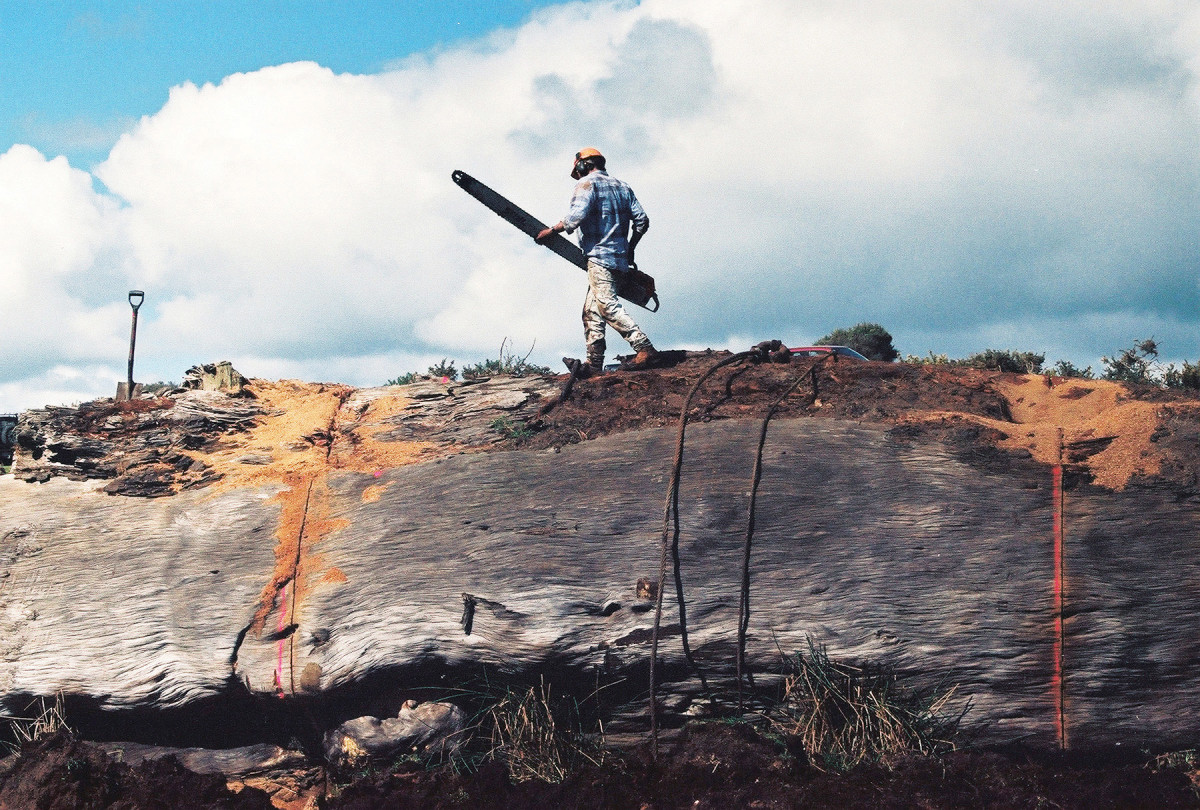
The bogs of New Zealand yield gargantuan Kauri logs.
Editor’s note: This article originally appeared in American Woodworker #139. Ancientwood is listed as permanently closed on Google but the website is still up at ancientwood.com and appears to have slabs for sale.
As I drive toward Ashland, Wisconsin—home of the company that lays claim to selling the oldest workable wood on the planet—the convoys of fully-loaded pulpwood trucks I pass remind me of the rich, ongoing logging tradition of the area. It’s a fitting place for a company named Ancientwood to call home. I find the pole building that serves as the warehouse/store/Internet headquarters, and find owner, Bob Teisberg. He greets me by making three introductions: The first is to his shop helper, Dante; the second is to a mammoth slab of Kauri wood standing by the door; the third is to his sense of humor. “Yep, we call that slab Dante’s Inferno. He went through hell for two straight weeks sanding and finishing that baby. But just look at it.” And when you look closely at this gigantic slab, you set your eyes on things of an unworldly nature. For starters, it’s 5 feet wide, 7 feet tall and three inches thick. It’s sanded smooth as glass with a finish and grain that not only glow but dance like a hologram based on your viewing angle. The color, figure and texture are unlike any wood I’ve ever seen. And the reason is, it is a wood I’ve never seen. It’s a wood most people have never seen. The slab is from a 50,000-year old Kauri tree, mined from the bogs of New Zealand.
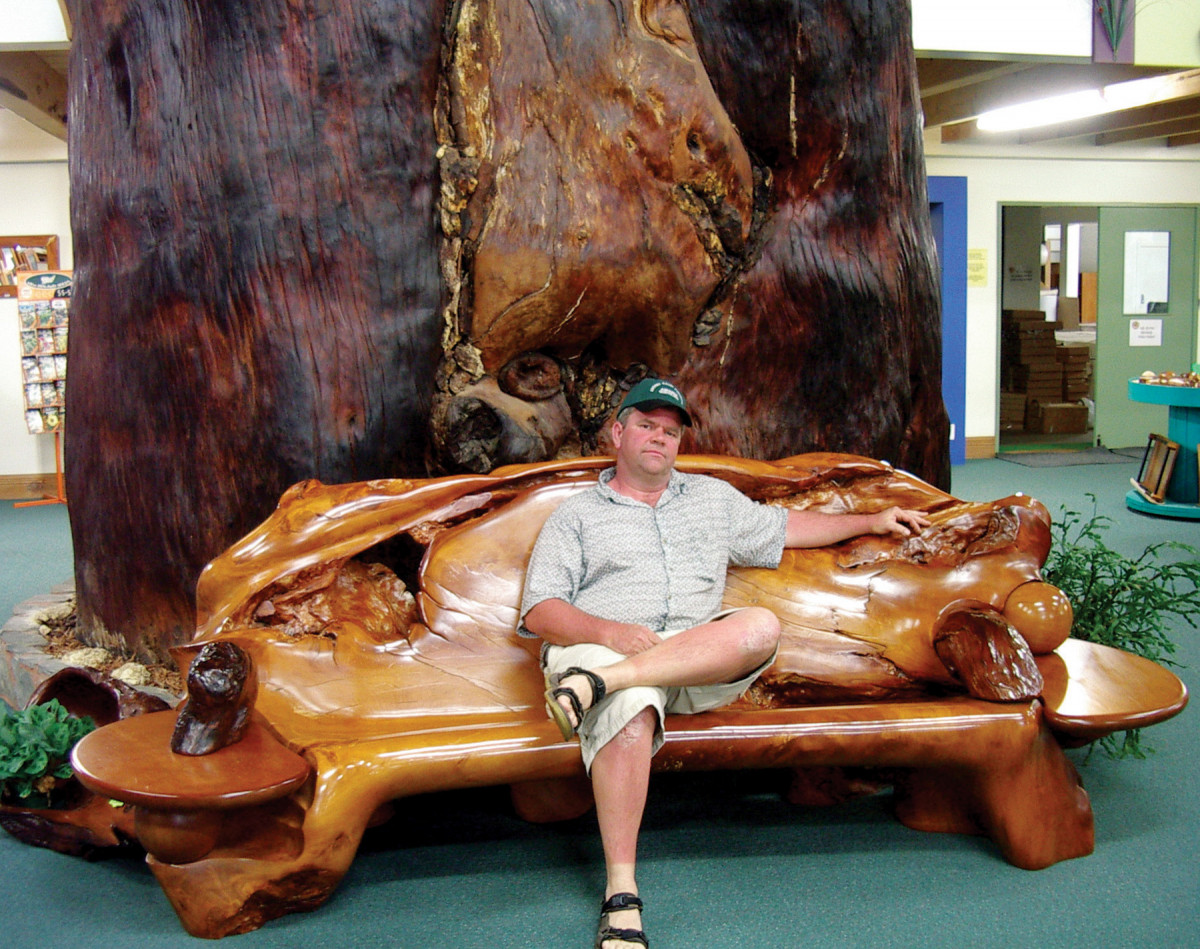
Bob Teisberg, owner of AncientWood, rests on a Kauri bench crafted from 50,000-year-old wood mined from the bogs of New Zealand. Behind him towers the mammoth “staircase log.”
The route a slab of wood needs to travel to get from 48,000 B.C. on the North Island of New Zealand to 2006 A.D. in Ashland, Wisconsin is not an easy, inexpensive or clean one. “Originally we thought some cataclysmic event—a tsunami, an earthquake, an asteroid—was responsible for the death of the trees,” explains Teisberg, the North American distributor for Ancient Kauri Kingdom wood. “But when they sent samples to the University of New Zealand for study, they found the trees died at different times, and fell in different directions, so our best guess is they died of natural causes.” But it doesn’t matter so much how they died as where and when they died. When most trees die, they keel over and decompose within a few decades. But these Kauri trees keeled over into bogs, an oxygen-starved, fungus-free environment, that created a time-warp cocoon that preserved the timber in pristine condition—until a Kiwi by the name of David Stewart happened along.
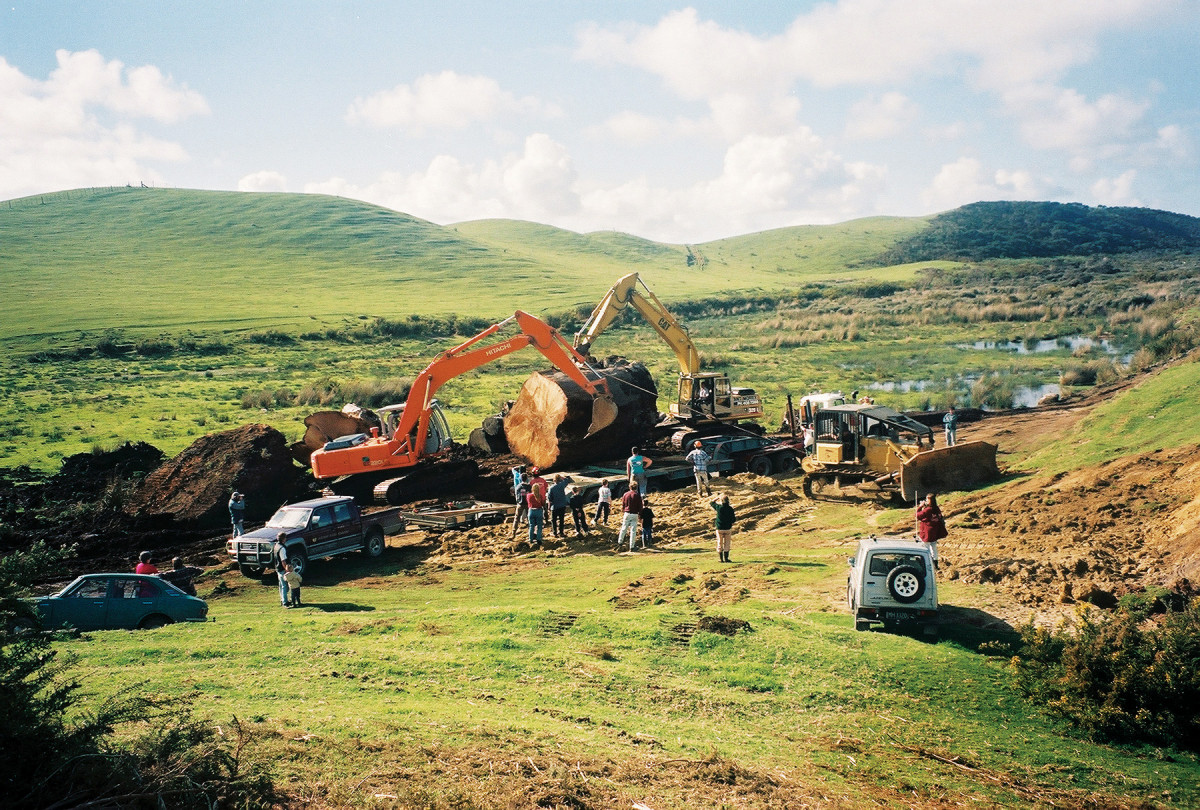
Extracting the ancient Kauri logs—some weighing as much as 140 tons—requires massive amounts of machinery, know-how and manpower.
The Ancient Kauri Kingdom’s informational DVD, in which Stewart stars, shows the process used to extract the trees. Most of the trees are found in farm pastures where they reveal their presence by a small exposed section. “If you’re a farmer you really don’t want these things in your field,” explains Teisberg. “Nothing grows on them and animals can break a leg if they fall through a rot pocket, so they’re just a nuisance.” When they go into an area they’re never quite sure what condition or size the trees will be in; there’s really nothing scientific about it. They get in there with a backhoe, give the exposed part a wiggle and if the land 100 feet around them moves they know they’ve got a monster. And they’ve found some monsters.
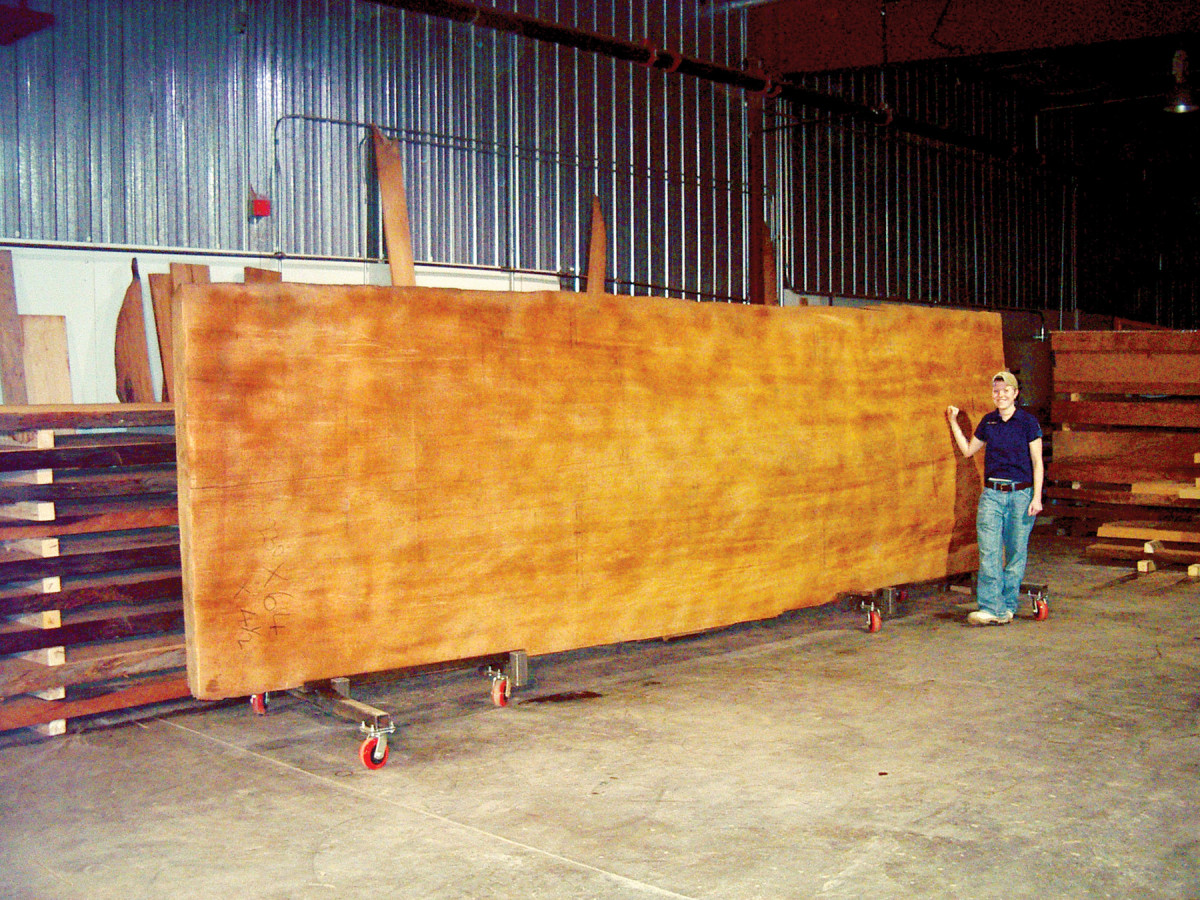
A knot-free slab of ancient Kauri wood in the warehouse in Bayfield Wisconsin. Twenty feet long, 5-1/2 feet wide and 4-1/2 inches thick, it may lay claim to being the largest single board in the world.
The extraction process involves moving man and machine across the boggy land, trenching all around the log, then using a chainsaw with a bar the length and lethalness of an alligator to cut the log in two if it’s too large to get out in one piece. The video of the process, which absolutely oozes testosterone, shows a cigarette-chomping Stewart, covered in slime, standing in the bucket of the backhoe, sawing a 60,000 pound monster in two with a chainsaw sporting a 6 foot long bar. There are hydraulics, chains, cables, muck and heavy machinery everywhere. The wood chips flying out of the kerf look as clean and uniform as if he were slicing through a 25-year old birch tree. At one point he pauses to show the camera a handful of 45,000-year old Kauri leaves.
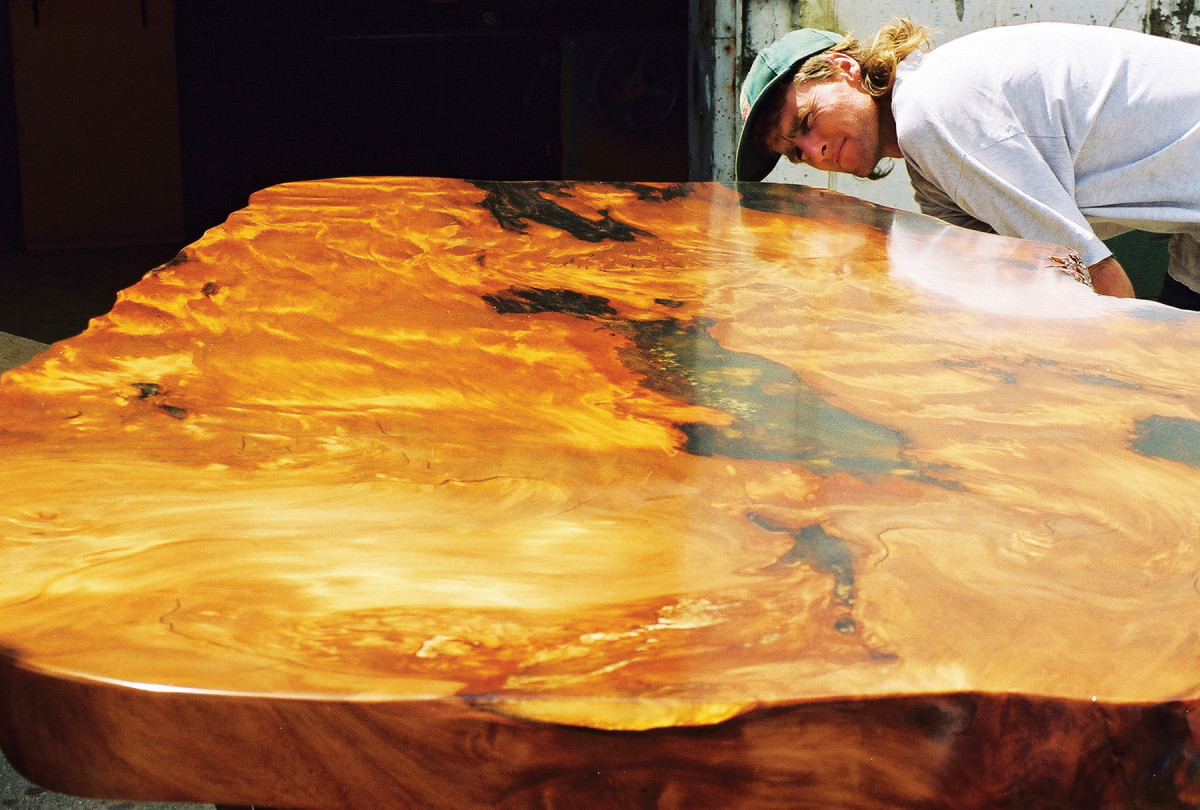
A worker eyes a finished slab of kauri wood that will soon serve as a tabletop. “White bait” and other unique grain patterns give the wood an iridescent quality.
Once the sections are cut to manageable size, they’re winched, pushed and pulled up out of the trench; rolled onto massive flat bed trucks, then hauled to the company’s yard where they’re marked and cut into slabs. The logs have reached the 100% saturation point after lying in the bogs for eons, and the drying process is a long, drawn out affair as the wood finds a new moisture balance.
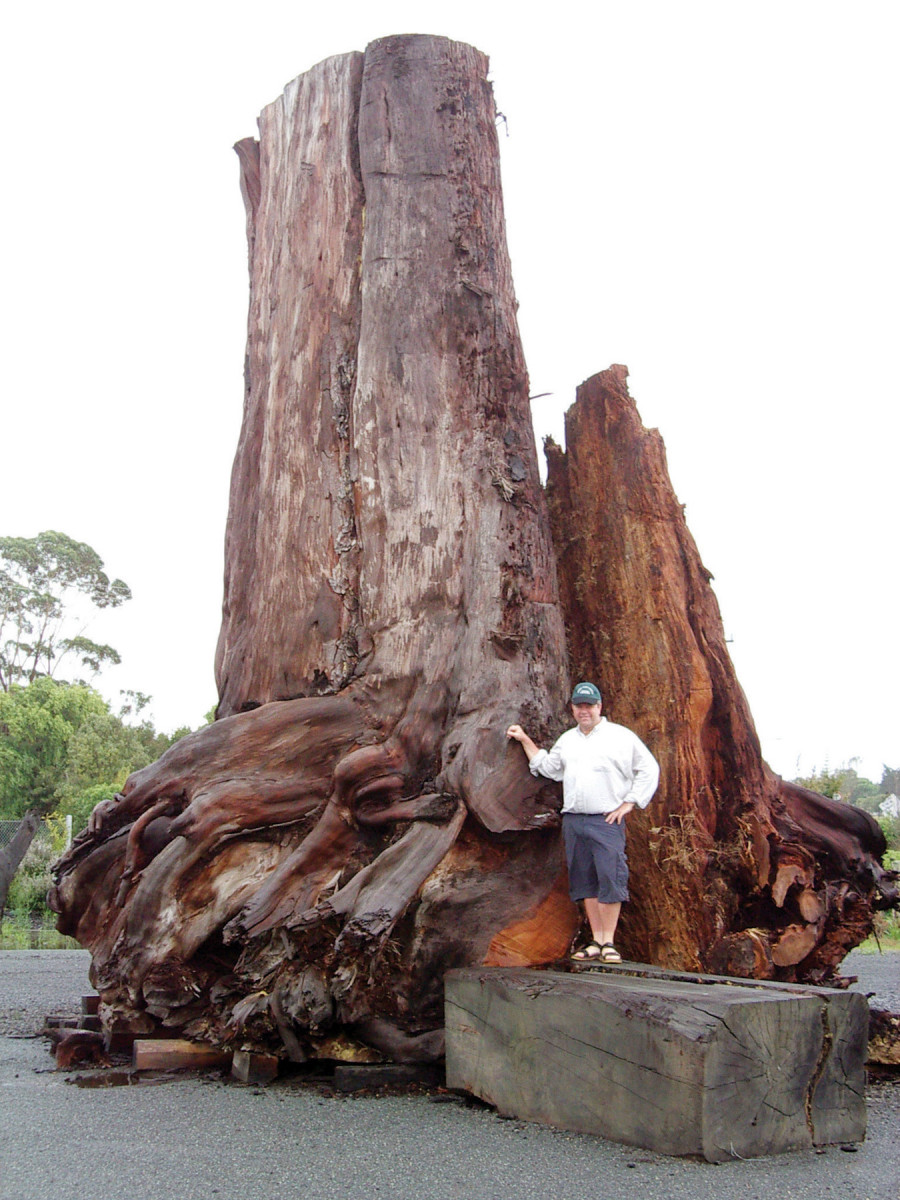
The crown prince of Kauri logs is the 140-ton “Staircase” log discovered in October of 1994; the largest known log of any kind, anywhere ever to be extracted. The crew broke two 90-ton capacity winch cables attempting to haul the trunk out in a single piece. They cut the tree into separate 110- and 30-ton sections, hauled the sections out, then let them sit untouched, not wanting to cut the trunk into slabs because of its Olympic-caliber size. Four years later, Stewart built a 20 inch thick reinforced concrete pad, placed a 50 ton, 12 foot diameter, 17 foot tall section of log on top of it, and went after it with a chainsaw. After three hundred hours of carving and two hundred hours of finish work, the world’s largest, and surely oldest, single-piece circular stairway was complete. It’s built inside of the log. If you pause to count the growth rings as you’re ascending you’ll find 1,087 of them.
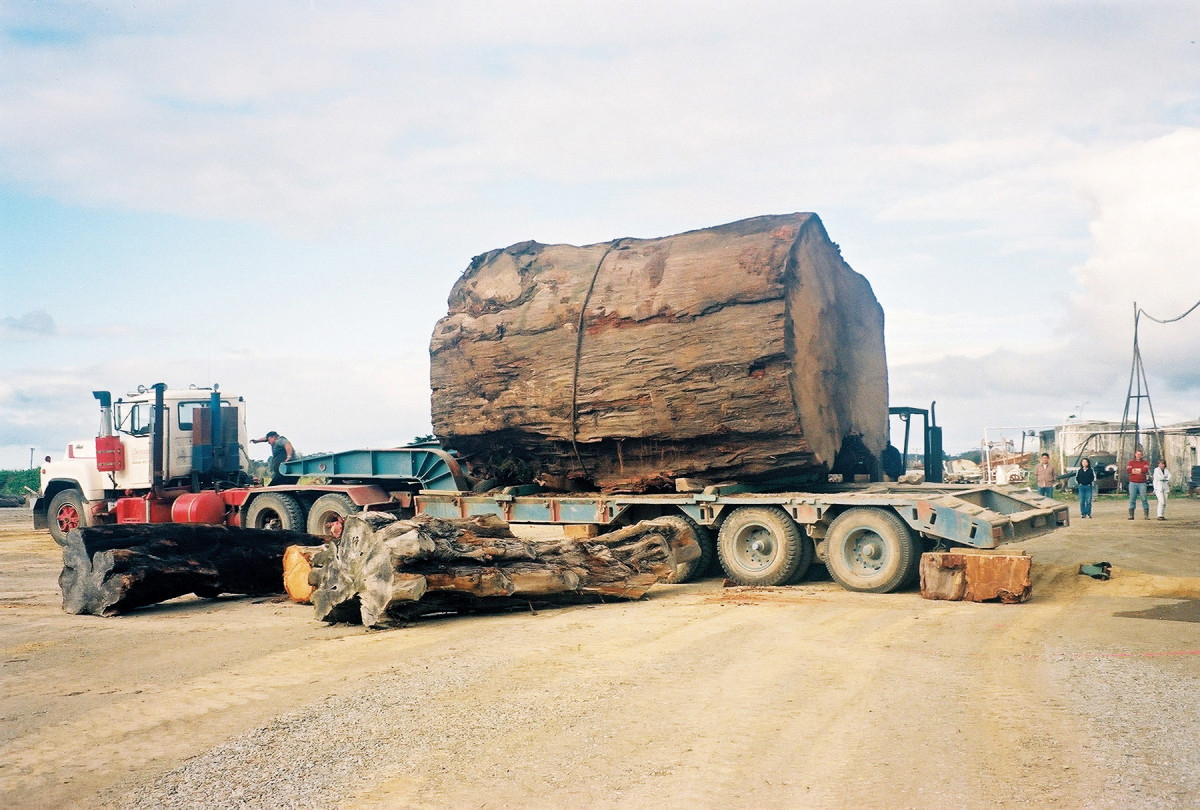 The scene in Ashland, Wisconsin is considerably tamer. Teisberg walks me past pile after pile, specimen after specimen of imported ancient Kauri. He has everything ranging from 6-foot thick stumps to 1/16th inch thick veneers. Teisberg, at one point, stocked what he touted to be the “largest single piece of wood available in the U.S.”—and I never found any challengers. The slab measured over 20 feet long, 5-1/2 feet wide, 4-1/2 inches thick, was estimated to be 1000 years old and, amazingly, contained not a single knot.
The scene in Ashland, Wisconsin is considerably tamer. Teisberg walks me past pile after pile, specimen after specimen of imported ancient Kauri. He has everything ranging from 6-foot thick stumps to 1/16th inch thick veneers. Teisberg, at one point, stocked what he touted to be the “largest single piece of wood available in the U.S.”—and I never found any challengers. The slab measured over 20 feet long, 5-1/2 feet wide, 4-1/2 inches thick, was estimated to be 1000 years old and, amazingly, contained not a single knot.
Kauri sells for $35 per board foot, a price comparable to that of high-grade teak today. “Teak is beautiful,” explains Teisberg, “But you’ll find it on every freakin’ sailboat made today. If you dig the [Kauri] story and you want something exotic, then you’re way in. If not, head to Home Depot.”
It’s not only boat builders who dig the Kauri story. Scientists are studying the growth rings to get a read on the climate and environment 50,000 years ago. Many of the boards have 50 to 60 growth rings per inch. They have stories to tell.
Fifty-thousand years old is getting on in age for a piece of wood, but Mike Peterson, a forester with Forestry Tasmania, believes he’s found wood that makes ancient Kauri wood look downright pubescent. In the 1930s, Huon pine logs that had been buried in an alluvial plain in the Stanley River region, were uncovered during a tin mining operation. Initially pieces were dated as being 7500 years old. Then in 1994 carbon dating revealed some to be 38,000 years old. Now scientists are examining Huon pine logs containing extraordinarily wide growth rings; growth rings that reveal these trees grew during an exceedingly warm period of the earth’s history—perhaps pre-glacial—which could make them 130,000 years old. But the tree ring chronology jury is still out.
The oldest non-petrified piece of wood on the planet may be the small hunk of Cupressinoxylon wood that wood collector, Richard Crow, has sitting on a shelf. It’s estimated to be 7 million years old but, apart from its deep black in color, “looks like it was felled a year ago,” according to Crow.
None of this makes Kauri wood any less amazing. Though in its raw state, the wood looks fairly unremarkable, it begins emitting its trademark opalescent glow once sanded down to 1200 grit and given a finish. The farther you get down into the base of the trunk and root area, the wilder the grain and figure become. Furniture builders love the stuff, crafting it into both highly machined and natural edge pieces. Turners like turning it wet, letting it dry out—sometimes for as long as two years—then turning it again to final shape and thickness. Musical instrument builders—including those who make guitars, ukuleles, drums, flutes and harps—love both the look and sound. One acoustic guitar maker now uses Kauri exclusively, and electric guitar builders in particular go wild for the boards with the wildest grain. One woodworker/jeweler sells rings turned from ancient Kauri and totes them as keepsakes that connect the wearer to their prehistoric past.
The wildest of the wildest grains is called “white bait,” named after schools of small fish near New Zealand that emit an iridescent glow when swimming in one direction, then seem to disappear when changing course. “People ask me to describe white bait over the phone and it really defies description,” explains Teisberg. “There’s no short description; it’s like a confluence of grain activities. I’ve never seen it in another type of wood. You just sort of have to see it.” And when you hold a sanded, polished and finished board of white bait in the sun, you see what he means. It has depth, it shimmers, it plays practical jokes on you depending on how you turn it.
As we head back toward his office, Teisberg picks up a slab of Kauri and tells me to rub my thumb “until it gets hot” over an area of the bark that contains an amber-color residue. “Now close your eyes and smell your thumb,” he says. “That’s what is smells like to stand in a 50,000 year old forest.” He may be right, but the smell is so intense, I feel like I’m standing in a 55-gallon drum of turpentine. The residue on my thumb is the dried sap of the Kauri, which clings to the bark whether the tree is long dead or still growing. In the not too distant past this sap was collected, purified and sent by the boatload to England and Norway to make linoleum and varnish.
Kauri was to New Zealand what white pines were to North America: massive and abundant trees ready for the taking by early European settlers who harvested them for houses, ship building, furniture and fire wood. When Captain Cook first reported the existence of “—the finest timber my eyes have ever seen—” in 1769, kauri forest blanketed about 4 million acres of New Zealand’s North Island. (2) The trees were massive by any standards. If you were a European carpenter, a single kauri could provide enough wood for six houses. If you were a Maori warrior you could craft one into a 115-foot long war canoe, capable of carrying a crew of eighty.
Some monsters escaped the guillotine; “Tane Mahuta,” perhaps the largest Kauri still growing today, measures 45 feet in circumference and stands 170 feet tall. But a tree known as “Kairaru,” that was destroyed by fire in the 1880s, was three times the size of Tane Mahuta. When living, it was the largest tree by volume in the world, larger than the largest redwoods today, and was estimated to be over 4,0000 years old. (3)
Before leaving I decide to purchase a 3-inch thick, 16 by 24 inch free-form slab, sliced from the base of an ancient Kauri. I gulp a bit when Teisberg calculates the board feet and the total comes to $315. But it’s a gorgeously entangled slab and, like a fine art lithograph, comes with its own serial number and certificate of authenticity; a certificate that reads in part:
This prehistoric Kauri timber is from the forests buried during the 1st Ice Age, which are located on the Northern Island of New Zealand in the South Pacific Ocean. Our company, Ancientwood, Ltd. is satisfied that extensive and conclusive independent Radio Carbon Dating tests verify this age beyond doubt.
And I think, “For a slab of 50,000 year old wood that’s traveled halfway around the world, 315 bucks is a pretty good deal.”
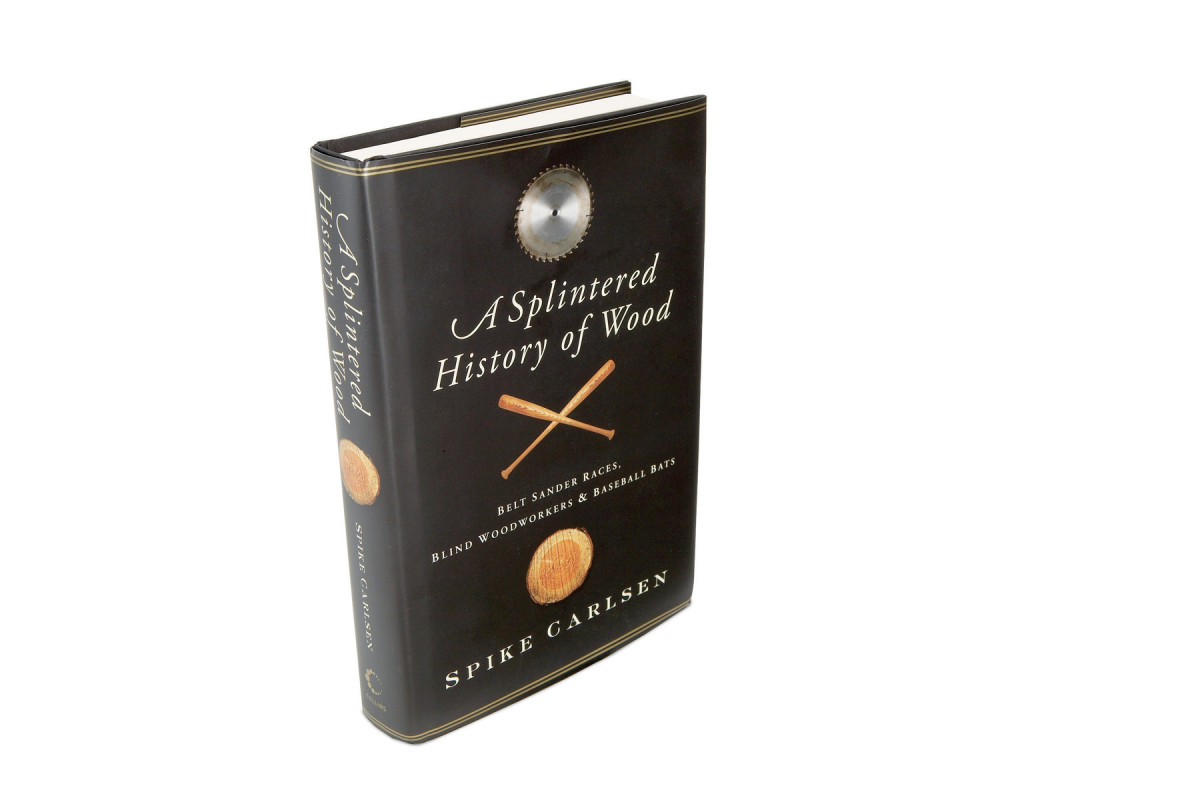
Excerpted from A Splintered History of Wood: Belt Sander Races, Blind Woodworkers and Baseball Bats by Spike Carlsen, published by HarperCollins. More information at spikecarlsen.com
Here are some supplies and tools we find essential in our everyday work around the shop. We may receive a commission from sales referred by our links; however, we have carefully selected these products for their usefulness and quality.









